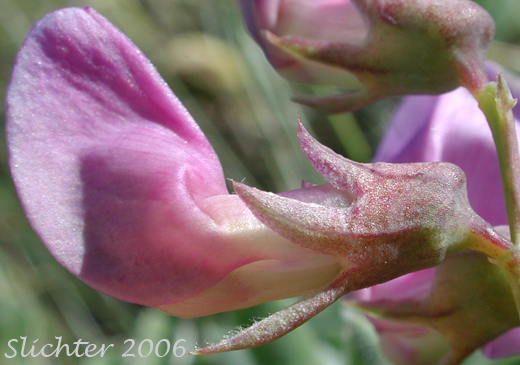 The photo at right shows a close-up of the calyx of Lathyrus
pauciflorus var. pauciflorus as seen at the crest of the Columbia Hills........May 14, 2006.
The photo at right shows a close-up of the calyx of Lathyrus
pauciflorus var. pauciflorus as seen at the crest of the Columbia Hills........May 14, 2006.Few-flowered Pea is a spreading to erect perennial wildflower with one to several simple to branched stems arising from 30-100 cm long from a buried crown atop a taproot. The foliage and stout, angled stems are typically glabrous or glaucous, although the margins of the calyx teeth may be ringed with minute hairs. The leafy stipules are generally wider than long and range from 2-26 mm long and 12-35 mm wide. The leaves are thick and leathery, and the 5-11 leaflets are linear, narrowly lanceolate, elliptic or ovate-obovate in shape. The leaves (including the branched tendrils) measure 7-17 cm long while the leaflets measure from 3-7 cm long and 0.2-2.6 cm wide.
The inflorescence consists of a raceme of 2-11 loosely spaced flowers atop a flower stem that is generally held above the uppermost leaves. The broadly cup-shaped calyx tube measures from 4.5-6.5 mm long with 5 ciliate-margined teeth. The uppermost pair of teeth are shorter than the 3 lower teeth, which are nearly as long as the calyx tube. The corolla measures 2.5-3.5 cm long and is lilac, violet or orchid in color. The banner is 15-26 mm long while the wings are slightly shorter and the keel much-shorter. The obliquely lanceolate fruits are glabrous and measure from 3-6 cm long and 6-11 mm wide.
Often found with sagebrush, few-flowered pea may also be found in grasslands, amongst ponderosa pine or montane forests, and on talus from 100-2500 meters of elevation.
Few-flowered pea may be found east of the Cascade Mts. from Chelan County, Washington east to Idaho and south to southern California and at the eastern edge of its range, through central Utah and southwestern Colorado to northeastern Arizona.
In the Columbia River Gorge, it may be found between the elevations of 100'-3500' from east of the Little White Salmon River eastward to Biggs Junction.